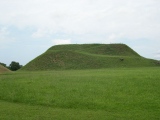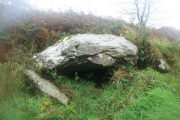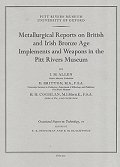<< Other Photo Pages >> Etowah Mounds - Mound A - Artificial Mound in United States in The South
Submitted by woode on Tuesday, 20 December 2022 Page Views: 9229
Pre-ColumbianSite Name: Etowah Mounds - Mound ACountry: United States Region: The South Type: Artificial Mound
Nearest Town: Cartersville
Latitude: 34.125000N Longitude: 84.8075W
Condition:
| 5 | Perfect |
| 4 | Almost Perfect |
| 3 | Reasonable but with some damage |
| 2 | Ruined but still recognisable as an ancient site |
| 1 | Pretty much destroyed, possibly visible as crop marks |
| 0 | No data. |
| -1 | Completely destroyed |
| 5 | Superb |
| 4 | Good |
| 3 | Ordinary |
| 2 | Not Good |
| 1 | Awful |
| 0 | No data. |
| 5 | Can be driven to, probably with disabled access |
| 4 | Short walk on a footpath |
| 3 | Requiring a bit more of a walk |
| 2 | A long walk |
| 1 | In the middle of nowhere, a nightmare to find |
| 0 | No data. |
| 5 | co-ordinates taken by GPS or official recorded co-ordinates |
| 4 | co-ordinates scaled from a detailed map |
| 3 | co-ordinates scaled from a bad map |
| 2 | co-ordinates of the nearest village |
| 1 | co-ordinates of the nearest town |
| 0 | no data |
Internal Links:
External Links:
I have visited· I would like to visit
reer01 sitedowser have visited here

More information can be found at: The New Georgia Encyclopedia: Etowah Mounds (The site incorrectly states that the human effigy sculptures uncovered here are clay, when they are actually marble.) and also the Georgia Department of Natural Resources website, including admission prices and times.
See below for details of geophysical study describing Etowah Mounds village and communal buildings.
You may be viewing yesterday's version of this page. To see the most up to date information please register for a free account.









Do not use the above information on other web sites or publications without permission of the contributor.
Click here to see more info for this site
Nearby sites
Click here to view sites on an interactive map of the areaKey: Red: member's photo, Blue: 3rd party photo, Yellow: other image, Green: no photo - please go there and take one, Grey: site destroyed
Download sites to:
KML (Google Earth)
GPX (GPS waypoints)
CSV (Garmin/Navman)
CSV (Excel)
To unlock full downloads you need to sign up as a Contributory Member. Otherwise downloads are limited to 50 sites.
Turn off the page maps and other distractions
Nearby sites listing. In the following links * = Image available
101m ESE 117° Etowah Mounds - Mound C* Artificial Mound
126m SSW 192° Etowah Mounds - Mound B* Artificial Mound
270m N 0° Etowah Mounds - Ditch and Palisade* Misc. Earthwork
336m N 9° Etowah Mounds Museum* Museum
2.5km NNW 333° Arborrigg* Modern Stone Circle etc
32.0km NE 47° Funk Heritage Center* Museum
71.4km N 8° Fort Mountain Stone Enclosure* Cairn
73.1km W 281° Coker Ford Site* Ancient Village or Settlement
91.1km WSW 247° Shelton Stone Mound Complex* Cairn
98.3km W 279° Collinsville Indian Mound* Artificial Mound
100.3km WSW 241° Choccolocco Stone Standing Stone (Menhir)
107.1km WSW 237° Oxford Stone Mound* Artificial Mound
107.8km WSW 238° Choccolocco Creek Mounds* Artificial Mound
110.4km SW 215° Rother L. Harris Reservoir Stone Standing Stone (Menhir)
110.9km SW 234° Talladega National Forest Stone 1Ta756 Standing Stone (Menhir)
115.0km NNW 339° Roxbury Indian Mound* Artificial Mound
115.5km NE 55° Hickorynut Track Rock* Rock Art
118.4km ENE 58° Nacoochee* Barrow Cemetery
120.1km NE 45° Track Rock* Rock Art
120.1km NE 45° Track Rock Gap Archaeological Area* Stone Row / Alignment
120.5km ENE 59° Kenimer* Artificial Mound
121.2km ENE 59° Sautee-Nacoochee earthwork Ancient Village or Settlement
122.0km N 356° Candies Creek Village Archaeological Preserve* Ancient Village or Settlement
132.0km NW 316° Russell Cave Mound* Artificial Mound
132.0km NW 316° Russell Cave* Cave or Rock Shelter
View more nearby sites and additional images






 We would like to know more about this location. Please feel free to add a brief description and any relevant information in your own language.
We would like to know more about this location. Please feel free to add a brief description and any relevant information in your own language. Wir möchten mehr über diese Stätte erfahren. Bitte zögern Sie nicht, eine kurze Beschreibung und relevante Informationen in Deutsch hinzuzufügen.
Wir möchten mehr über diese Stätte erfahren. Bitte zögern Sie nicht, eine kurze Beschreibung und relevante Informationen in Deutsch hinzuzufügen. Nous aimerions en savoir encore un peu sur les lieux. S'il vous plaît n'hesitez pas à ajouter une courte description et tous les renseignements pertinents dans votre propre langue.
Nous aimerions en savoir encore un peu sur les lieux. S'il vous plaît n'hesitez pas à ajouter une courte description et tous les renseignements pertinents dans votre propre langue. Quisieramos informarnos un poco más de las lugares. No dude en añadir una breve descripción y otros datos relevantes en su propio idioma.
Quisieramos informarnos un poco más de las lugares. No dude en añadir una breve descripción y otros datos relevantes en su propio idioma.